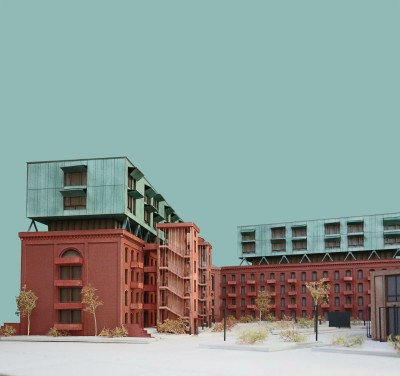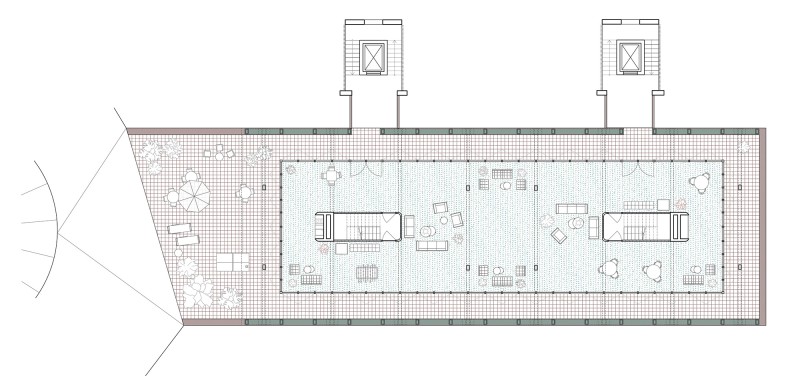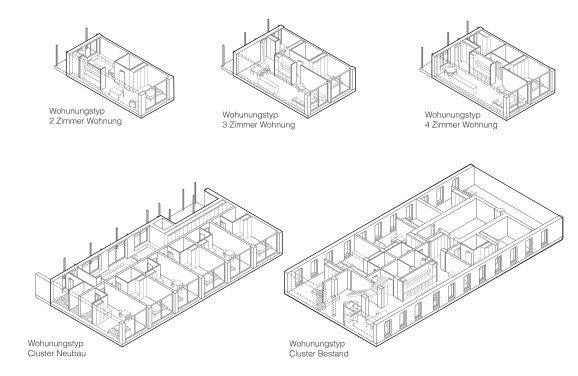Feldlabor Tagebau Hambach – Institut für Pflanzenwissenschaften Morschenich
Published by the Department of Design and Building Technology (Prof. Anett-Maud Joppien).
The design task called for a plant research center on the site of a former equestrian farm on the southeastern edge of the village of Morschenich. The center was to include an office, marginal field labs, greenhouses and integral test areas for modern and digitally optimized agriculture.
The plant research center, consisting of an office, marginal field labs, greenhouses and integral test areas for modern and digitally optimized agriculture, is to be built on the site of a former equestrian farm on the southeastern edge of the village of Morschenich. For the most part, the various uses will be accommodated in the existing building for this purpose. New additions include two greenhouse hybrids, which will be expanded to include the function of workshop and conference spaces. As a house-within-a-house, they will use the greenhouse as a climatic envelope.
The existing building will be partly extended with roof overhangs as sun protection as well as green roofs and green facades. The volume of the former riding arena is broken through to create clearly defined zones and provide a passage to the guest house. For the guest house, which can accommodate up to eight researchers, an existing neighboring building will be reactivated and climatically optimized with a polycarbonate shell.
A community house for Morschenich’s new residents will be established in the existing lunge rotunda, which, in addition to its small growing area for communal gardening, will provide the growing community with a place for fellowship.
In my design, I retain almost the entire footprint of the old equestrian farm. With a few breakthroughs within the courtyard, a new campus structure is created. An interplay of research fields and institute buildings is created. At the same time, the former riding hall moves into the center of attention. It functions as a new storage facility and greenhouse, which will also house the exhibition. The clinker walls with the existing steel structure will be retained and form the new base of the greenhouses. The existing walls will be topped with a simple greenhouse structure to form the outer shell. Inside are boxes made of a wooden structure. The old residential building will be converted into a bistro on the first floor and provide overnight accommodations for visitors on the upper floor.
The office is being built in the front campus building. Directly behind it is the former riding hall with the new functions of storage, greenhouse and exhibition. Next to it – to the south – is the new workspace of the Marginal Lab. The smaller stables in the northeast now contain the workshop areas and workshops.
All buildings are connected to the new greenhouse by very short paths. A generous walkway around the campus area allows visitors to also take a look at the fields. In addition, visitors can walk into the greenhouse from the forecourt to view the latest research results or visit the exhibition on the top level
The design for the field laboratory is based on the existing village and building structures, interpreting and translating them into a new form. The field laboratory thereby forms a gentle transition from the village structure into the landscape. As a direct mediator to the site, the existing and site-defining residential building is preserved. The newly designed field laboratory deliberately takes a back seat and exposes the residential building.
Facing the site, the greenhouse stands as an identity-forming distinctive feature for the field laboratory. The warehouse forms a counterpart on the other side of the residential building in the direction of the village exit. Both parts of the building are connected by a flat, three-armed and multi-curved structure, which at the same time forms an inner courtyard and creates a soft, green transition into the landscape.
The field laboratory will promote exchange through its open structures and become an agricultural research object itself through its green roof rising from the ground.
This proposal for the research site Marginal Field Labs of the initiative Bioökonomie-Revier forms the threshold between the village structure of the resettled Morschenich and the surrounding farmland, which is to become a large-scale experimental area. With the elongated setting orthogonal to the road, the proposal picks up the local-village courtyard structure and staggers it in varying succession. Through the meandering arrangements of the uses of the predominantly single-story floor plan, the building opens up with two courtyards, one to the north and one to the south, ultimately forming a more introverted courtyard. The public and communal uses such as exhibition, workshop and bistro are arranged in the center of the floor plan, open to all three courtyards and can be connected to each other. An overarching modular system allows the building to be expanded to provide space for additional research projects of the initiative and unite them in one location. With the overlay of the agricultural open space structure and the interpretation of the village building structure, the field laboratory forms a threshold space between field and village.
In the concrete architectural elaboration of the field laboratory, the themes of vegetation – open space – sensitivity and experienceability are particularly important. Both the task and the existing building structure refer to a kind of institute – city – courtyard structure. The existing granularity and volumetrics are to be preserved and only complemented to scale. By reducing the built architecture to its supporting elements, the enclosed space is interwoven with the landscape space.
This expressionistic design approach is continued in the addition of the three new buildings. Along the linear grid of paths, the two horizontal greenhouse buildings reinforce the reading of an independent urban structure. Despite the high level of building mass preservation, the design succeeds in naming the themes of transparency and horizontality as unifying elements in all the buildings. The linearity of the building structure is continued in the interior. The open floor plans serve as flexibly usable spaces and are similar in linear orientation despite their different uses. The essential element is a horizontal band that appears as a table, planter or exhibit. The interior spaces are linked by use and interweave with the exterior spaces.
All areas can be used or viewed both externally and internally, so that the transparency of the research is followed by an acceptance of the visitors. The basic principle of conversion and new construction can be extended at will across the adjacent urban structure. The adjacent open spaces develop along the buildings and lead into the existing vegetation structures.
In the concrete architectural elaboration of the field laboratory, the themes of vegetation – open space – sensitivity and experienceability are particularly important. Both the task and the existing building structure refer to a kind of institute – city – courtyard structure. The existing granularity and volumetrics are to be preserved and only complemented to scale. By reducing the built architecture to its supporting elements, the enclosed space is interwoven with the landscape space.
This expressionistic design approach is continued in the addition of the three new buildings. Along the linear grid of paths, the two horizontal greenhouse buildings reinforce the reading of an independent urban structure. Despite the high level of building mass preservation, the design succeeds in naming the themes of transparency and horizontality as unifying elements in all the buildings. The linearity of the building structure is continued in the interior. The open floor plans serve as flexibly usable spaces and are similar in linear orientation despite their different uses. The essential element is a horizontal band that appears as a table, planter or exhibit. The interior spaces are linked by use and interweave with the exterior spaces.
All areas can be used or viewed both externally and internally, so that the transparency of the research is followed by an acceptance of the visitors. The basic principle of conversion and new construction can be extended at will across the adjacent urban structure. The adjacent open spaces develop along the buildings and lead into the existing vegetation structures.
In the concrete architectural elaboration of the field laboratory, the themes of vegetation – open space – sensitivity and experienceability are particularly important. Both the task and the existing building structure refer to a kind of institute – city – courtyard structure. The existing granularity and volumetrics are to be preserved and only complemented to scale. By reducing the built architecture to its supporting elements, the enclosed space is interwoven with the landscape space.
This expressionistic design approach is continued in the addition of the three new buildings. Along the linear grid of paths, the two horizontal greenhouse buildings reinforce the reading of an independent urban structure. Despite the high level of building mass preservation, the design succeeds in naming the themes of transparency and horizontality as unifying elements in all the buildings. The linearity of the building structure is continued in the interior. The open floor plans serve as flexibly usable spaces and are similar in linear orientation despite their different uses. The essential element is a horizontal band that appears as a table, planter or exhibit. The interior spaces are linked by use and interweave with the exterior spaces.
All areas can be used or viewed both externally and internally, so that the transparency of the research is followed by an acceptance of the visitors. The basic principle of conversion and new construction can be extended at will across the adjacent urban structure. The adjacent open spaces develop along the buildings and lead into the existing vegetation structures.





























































